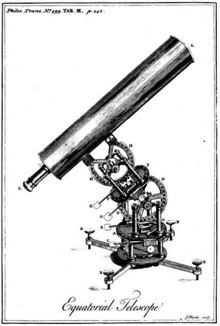
Ole Christensen Rømer was a Danish astronomer who, in 1676, made the first measurement of the speed of light.

1710 (MDCCX) was a common year starting on Wednesday of the Gregorian calendar and a common year starting on Sunday of the Julian calendar, the 1710th year of the Common Era (CE) and Anno Domini (AD) designations, the 710th year of the 2nd millennium, the 10th year of the 18th century, and the 1st year of the 1710s decade. As of the start of 1710, the Gregorian calendar was 11 days ahead of the Julian calendar, which remained in localized use until 1923.

James Bradley (1692–1762) was an English astronomer and priest who served as the third Astronomer Royal from 1742. He is best known for two fundamental discoveries in astronomy, the aberration of light (1725–1728), and the nutation of the Earth's axis (1728–1748).

John Arbuthnot FRS, often known simply as Dr Arbuthnot, was a Scottish physician, satirist and polymath in London. He is best remembered for his contributions to mathematics, his membership in the Scriblerus Club, and for inventing the figure of John Bull.

William Cullen FRS FRSE FRCPE FPSG was a Scottish physician, chemist and agriculturalist, and professor at the Edinburgh Medical School. Cullen was a central figure in the Scottish Enlightenment: He was David Hume's physician, and was friends with Joseph Black, Henry Home, Adam Ferguson, John Millar, and Adam Smith, among others.
The year 1758 in science and technology involved some significant events.
The year 1714 in science and technology involved some significant events.
The year 1712 in science and technology involved some significant events.
The year 1693 in science and technology involved some significant events.
The year 1676 in science and technology involved some significant events.

A transit of Venus across the Sun takes place when the planet Venus passes directly between the Sun and a superior planet, becoming visible against the solar disk. During a transit, Venus can be seen from Earth as a small black dot moving across the face of the Sun. The duration of such transits is usually several hours. A transit is similar to a solar eclipse by the Moon. While the diameter of Venus is more than three times that of the Moon, Venus appears smaller, and travels more slowly across the face of the Sun, because it is much farther away from Earth.
Abraham or Abram Robertson FRS, was a Scottish mathematician and astronomer. He held the Savilian Chair of Geometry at the University of Oxford from 1797 to 1809.
Events from the year 1710 in Great Britain.

Rømer's determination of the speed of light was the demonstration in 1676 that light has a finite speed and so does not travel instantaneously. The discovery is usually attributed to Danish astronomer Ole Rømer, who was working at the Royal Observatory in Paris at the time.

Henry Cullen FRSE FRCPE (c.1758—1790) was a Scottish physician. He was chair and professor of medicine at the Royal Infirmary of Edinburgh. From 1776 until his death in 1790 he was a physician-in-ordinary to the Royal Infirmary of Edinburgh.

On June 3, 1769, navigator Captain James Cook, naturalist Joseph Banks, astronomer Charles Green and naturalist Daniel Solander recorded the transit of Venus from the island of Tahiti during Cook's first voyage around the world. During a transit, Venus appears as a small black disc travelling across the Sun. Transits of Venus occur in a pattern that repeats itself every 243 years, with two transits that are eight years apart, separated by breaks of 121.5 and 105.5 years. These men, along with a crew of scientists, were commissioned by the Royal Society of London for the primary purpose of viewing the transit of Venus. Not only would their findings help expand scientific knowledge, it would help with navigation by accurately calculating the observer's longitude. At this time, longitude was difficult to determine and not always precise. A "secret" mission that followed the transit included the exploration of the South Pacific to find the legendary Terra Australis Incognita or "unknown land of the South."

EdmondHalley was an English astronomer, mathematician and physicist. He was the second Astronomer Royal in Britain, succeeding John Flamsteed in 1720.
Edward Haynes or Haines was an English astronomer and Fellow of the Royal Society.
Events from the year 1710 in Scotland.

The Kirkhill Astronomical Pillar was constructed in 1776 by David Stewart Erskine, 11th Earl of Buchan and erected in the grounds of his estate at Kirkhill House, near Broxburn, Scotland. The pillar fell into disrepair and eventually collapsed in the 1970's but fortunately the stones were preserved and the pillar was reconstructed (1988) in Almondell Country Park on land once owned by the Erskine family. The pillar records the details of an adjacent scale model of the Solar System constructed by Erskine following the measurements of the size of the Solar System deduced from the observations of the Transits of Venus in 1761 and 1769. The model, centred on a Sun of stone six feet in diameter with planets at distances and sizes to scale, has long since disappeared, only the pillar remains.











